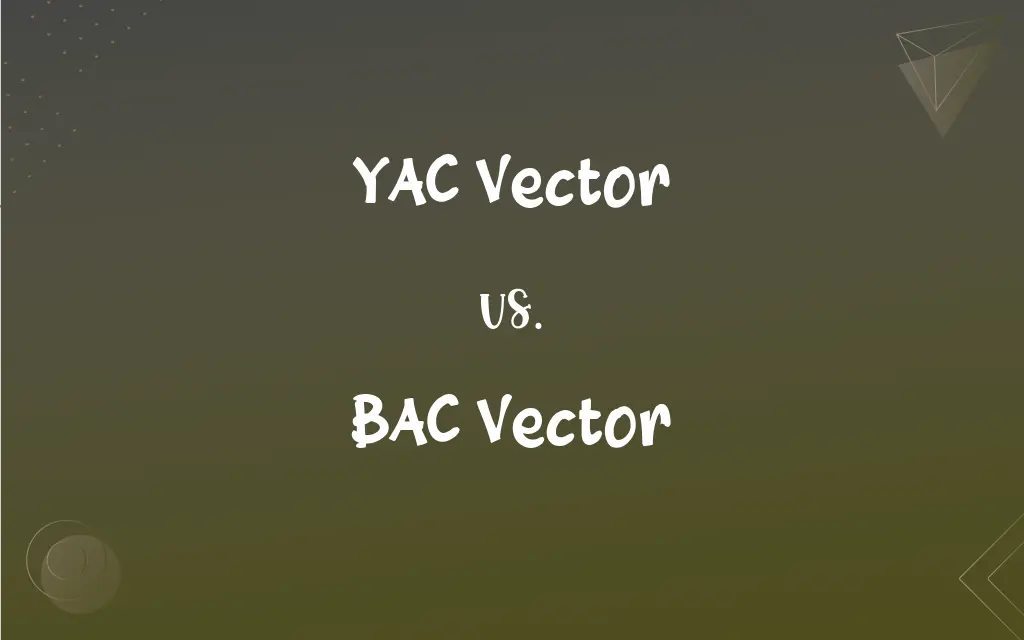YAC Vector vs. BAC Vector: What's the Difference?
Edited by Janet White || By Harlon Moss || Updated on October 27, 2023
YAC vectors (yeast artificial chromosomes) are used to clone large DNA fragments, while BAC vectors (bacterial artificial chromosomes) are for cloning moderately large DNA sequences.

Key Differences
YAC vectors are constructed using yeast DNA elements and can accommodate very large DNA inserts, up to several million base pairs. BAC vectors, derived from bacterial F-plasmid, typically hold DNA fragments up to 300,000 base pairs.
In YAC vectors, cloning large fragments can lead to stability issues and chimerism. BAC vectors are more stable and have lower chances of rearrangement, making them more reliable for certain applications.
YAC vectors are useful for cloning large genomic libraries and studying large genes or gene clusters. BAC vectors are commonly used in genome sequencing projects due to their stability and ease of manipulation.
The maintenance and replication of YAC vectors depend on yeast cellular machinery. In contrast, BAC vectors replicate within bacterial cells, utilizing bacterial replication systems.
YAC vectors require specialized yeast handling techniques for manipulation. BAC vectors, on the other hand, are manipulated using standard bacterial molecular biology techniques, making them more accessible.
ADVERTISEMENT
Comparison Chart
Origin
Yeast Artificial Chromosome
Bacterial Artificial Chromosome
DNA Capacity
Up to several million base pairs
Up to 300,000 base pairs
Stability
Less stable, prone to chimerism and rearrangements
More stable, fewer rearrangements
Common Uses
Large genomic libraries, studying large genes
Genome sequencing, precise genetic engineering
Host Organism
Yeast
Bacteria
ADVERTISEMENT
Manipulation
Requires specialized yeast handling techniques
Standard bacterial molecular biology techniques
Cloning Efficiency
Lower efficiency due to size and complexity
Higher efficiency
Cost and Accessibility
Generally more complex and costly
More cost-effective and accessible
Applications
Useful for studying complex genetic arrangements
Ideal for precise genetic studies and modifications
YAC Vector and BAC Vector Definitions
YAC Vector
A vector capable of carrying large DNA inserts.
The YAC vector facilitated the cloning of the entire genomic region.
BAC Vector
A tool for precise genetic engineering.
Geneticists used a BAC vector for targeted gene modifications.
YAC Vector
A vector used in advanced genetic research.
The YAC vector played a crucial role in their genetic study.
BAC Vector
A system for cloning DNA fragments up to 300,000 base pairs.
The BAC vector successfully cloned the 200,000 base pair sequence.
YAC Vector
A tool for studying eukaryotic gene function.
Researchers utilized a YAC vector to investigate the gene of interest.
BAC Vector
A vector preferred for its stability and ease of manipulation.
Researchers chose the BAC vector due to its reliable performance.
YAC Vector
A system used in constructing genomic libraries.
They constructed a genomic library using a YAC vector.
BAC Vector
A cloning vector derived from bacterial plasmids.
The BAC vector was ideal for cloning the moderate-sized DNA fragment.
YAC Vector
A cloning vector derived from yeast chromosomes.
The YAC vector was used to clone the large DNA segment.
BAC Vector
A vector used in genome sequencing projects.
The human genome project extensively utilized BAC vectors.
FAQs
What is a YAC vector?
A cloning vector derived from yeast chromosomes for large DNA fragments.
Are YAC vectors stable?
YAC vectors are less stable and prone to rearrangements.
What is a BAC vector?
A cloning vector from bacterial plasmids for moderately large DNA fragments.
What are YAC vectors commonly used for?
They're used for cloning large genomic libraries and studying large genes.
What are BAC vectors commonly used for?
They're used in genome sequencing and precise genetic engineering.
What organism hosts YAC vectors?
YAC vectors are maintained and replicated in yeast cells.
Can BAC vectors be used in genome projects?
Yes, BAC vectors are extensively used in genome sequencing projects.
What size DNA can BAC vectors accommodate?
BAC vectors typically hold DNA fragments up to 300,000 base pairs.
What is the cloning efficiency of BAC vectors?
BAC vectors have higher efficiency.
Do YAC vectors have applications beyond cloning?
They are also used for studying complex genetic arrangements.
What organism hosts BAC vectors?
BAC vectors are maintained and replicated in bacterial cells.
Are BAC vectors cost-effective?
BAC vectors are more cost-effective and accessible.
Do BAC vectors have applications beyond cloning?
They are ideal for precise genetic studies and modifications.
What is the cloning efficiency of YAC vectors?
YAC vectors have lower efficiency due to their size and complexity.
Are BAC vectors stable?
BAC vectors are more stable with fewer rearrangements.
How are BAC vectors manipulated?
They are manipulated using standard bacterial molecular biology techniques.
Are YAC vectors cost-effective?
YAC vectors are generally more complex and costly.
What size DNA can YAC vectors accommodate?
YAC vectors can accommodate DNA fragments up to several million base pairs.
Can YAC vectors be used in genetic research?
Yes, they are used in advanced genetic research.
How are YAC vectors manipulated?
They require specialized yeast handling techniques.
About Author
Written by
Harlon MossHarlon is a seasoned quality moderator and accomplished content writer for Difference Wiki. An alumnus of the prestigious University of California, he earned his degree in Computer Science. Leveraging his academic background, Harlon brings a meticulous and informed perspective to his work, ensuring content accuracy and excellence.
Edited by
Janet WhiteJanet White has been an esteemed writer and blogger for Difference Wiki. Holding a Master's degree in Science and Medical Journalism from the prestigious Boston University, she has consistently demonstrated her expertise and passion for her field. When she's not immersed in her work, Janet relishes her time exercising, delving into a good book, and cherishing moments with friends and family.































































